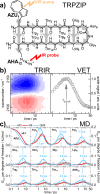Through bonds or contacts? Mapping protein vibrational energy transfer using non-canonical amino acids
- PMID: 34078890
- PMCID: PMC8172543
- DOI: 10.1038/s41467-021-23591-1
Through bonds or contacts? Mapping protein vibrational energy transfer using non-canonical amino acids
Abstract
Vibrational energy transfer (VET) is essential for protein function. It is responsible for efficient energy dissipation in reaction sites, and has been linked to pathways of allosteric communication. While it is understood that VET occurs via backbone as well as via non-covalent contacts, little is known about the competition of these two transport channels, which determines the VET pathways. To tackle this problem, we equipped the β-hairpin fold of a tryptophan zipper with pairs of non-canonical amino acids, one serving as a VET injector and one as a VET sensor in a femtosecond pump probe experiment. Accompanying extensive non-equilibrium molecular dynamics simulations combined with a master equation analysis unravel the VET pathways. Our joint experimental/computational endeavor reveals the efficiency of backbone vs. contact transport, showing that even if cutting short backbone stretches of only 3 to 4 amino acids in a protein, hydrogen bonds are the dominant VET pathway.
Conflict of interest statement
The authors declare no competing interests.
Figures



Similar articles
-
A donor-acceptor pair for the real time study of vibrational energy transfer in proteins.Phys Chem Chem Phys. 2014 Feb 21;16(7):3261-6. doi: 10.1039/c3cp54760d. Epub 2014 Jan 10. Phys Chem Chem Phys. 2014. PMID: 24413252
-
Versatile Vibrational Energy Sensors for Proteins.Angew Chem Int Ed Engl. 2022 May 16;61(21):e202200648. doi: 10.1002/anie.202200648. Epub 2022 Apr 6. Angew Chem Int Ed Engl. 2022. PMID: 35226765 Free PMC article.
-
Site-Resolved Observation of Vibrational Energy Transfer Using a Genetically Encoded Ultrafast Heater.Angew Chem Int Ed Engl. 2019 Feb 25;58(9):2899-2903. doi: 10.1002/anie.201812995. Epub 2019 Feb 6. Angew Chem Int Ed Engl. 2019. PMID: 30589180
-
Studying allosteric regulation in metal sensor proteins using computational methods.Adv Protein Chem Struct Biol. 2014;96:181-218. doi: 10.1016/bs.apcsb.2014.06.009. Epub 2014 Sep 6. Adv Protein Chem Struct Biol. 2014. PMID: 25443958 Review.
-
Energy flow in proteins.Annu Rev Phys Chem. 2008;59:233-59. doi: 10.1146/annurev.physchem.59.032607.093606. Annu Rev Phys Chem. 2008. PMID: 18393676 Review.
Cited by
-
Transient Structural Dynamics of Glycogen Phosphorylase from Nonequilibrium Hydrogen/Deuterium-Exchange Mass Spectrometry.J Am Chem Soc. 2024 Jan 10;146(1):298-307. doi: 10.1021/jacs.3c08934. Epub 2023 Dec 29. J Am Chem Soc. 2024. PMID: 38158228 Free PMC article.
-
Biomolecular infrared spectroscopy: making time for dynamics.Chem Sci. 2023 Nov 28;15(2):414-430. doi: 10.1039/d3sc05223k. eCollection 2024 Jan 3. Chem Sci. 2023. PMID: 38179520 Free PMC article. Review.
-
Non-canonical Amino Acid Substrates of E. coli Aminoacyl-tRNA Synthetases.Chembiochem. 2022 Jan 5;23(1):e202100299. doi: 10.1002/cbic.202100299. Epub 2021 Sep 22. Chembiochem. 2022. PMID: 34416067 Free PMC article. Review.
-
Structural Dependence of Extended Amide III Vibrations in Two-Dimensional Infrared Spectra.J Phys Chem Lett. 2023 Oct 19;14(41):9257-9264. doi: 10.1021/acs.jpclett.3c02662. Epub 2023 Oct 9. J Phys Chem Lett. 2023. PMID: 37812580 Free PMC article.
-
Ultrafast Dynamics in Flavocytochrome C by Using Transient Absorption and Femtosecond Fluorescence Lifetime Spectroscopy.J Phys Chem B. 2025 Apr 17;129(15):3731-3739. doi: 10.1021/acs.jpcb.4c05496. Epub 2025 Apr 8. J Phys Chem B. 2025. PMID: 40199724 Free PMC article.
References
-
- Leitner, D. M. & Straub, J. E. eds. Proteins. Energy, Heat and Signal Flow (CRC Press, 2010).
Publication types
MeSH terms
Substances
LinkOut - more resources
Full Text Sources

